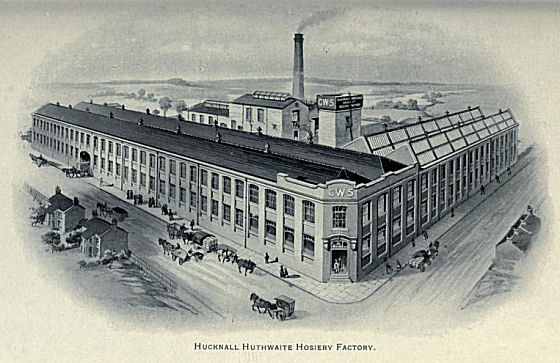Huthwaite CWS
Relocating CWS Hosiery Manufacturing
Our local press announced the opening of this new CWS Huthwaite hosiery factory in last week of 1907. It came a few months short of starting production, although that publicity must have been welcoming news for future business, as well as arousing interest of potential workers throughout the Christmas holidays.
There had obviously been strong argument against relocating works not only into another county, but also from a busy city environment into a rural setting. Nottinghamshire authorities had keenly encouraged CWS into making Hucknall Huthwaite a rightful choice. One winning key factor was an historic dependancy that fed wide repute at producing finest hosiery. The CWS historian poetically added description for our new location as healthful amidst delightful countryside. The only real negative issue was railway accessibility.
Like all respectable places, Huthwaite already boasted a railway platform for both goods and passengers. Only problem being, Whiteborough station remotely stood on the far west boundary around two miles from the factory site. Alternatively, and if not slightly nearer, a busier Sutton town station presented an easier road connection, especially for horse drawn carts. Ideas forwarded by Urban District Councillors failed to convince the railway companies into providing a central village station, although proving no great hindrance to an international CWS shipping company. Between talks and factory completion coming through modern day renaming, Huthwaite gained a regular passenger tram service, far better suiting employment needs.
This monumental building was specifically designed by Co-operative Wholesale Society Limited in order to fully take over and expand their hosiery manufacturing. Having taken over a year to complete, a few dozen staff initially overlooked fitments while awaiting full transfer of machinery from their Leicester works. The old CWS factory had fully employed 361. Those remaining were all invited to continue work through relocation, and an interesting number actually did. But the company expressed some concern about startup difficulties when only 14 out of 208 girls along with 16 out of 40 warehousemen took up opportunity to move area.
It was intimated this regions lower trade rate put them off. Regard ought have been given in asking mainly young single women to leave family homes to begin independent lives elsewhere. Nonetheless, and no matter how skillfully they performed lesser paid jobs, they could be replaced allowing for short periods of training. Operating huge machinery was the skilled occupation, and like all industrial equipment still best entrusted to males. The CWS must therefore have been relatively pleased when losing just 6 of its key operatives, because 48 would arrive in Huthwaite to very quickly start up their already familiar machines.

No photograph can yet compare with this exquisitely detailed sketch of a future Huthwaite hosiery factory. Penned by the architects leaves it bearing former village name when featured in later CWS annuals, and its from an 1914 issue which gives this brief background when first describing the working Huthwaite factory.
Hosiery Factory, Huthwaite.
The connection of the C.W.S. with hosiery began in 1903, when the Leicester Hosiery Factory, which had previously been run as a copartnership works, was taken over as a going concern. For about five years operations were carried on in the old building, but in 1908 the business was transferred to a new and commodious factory designed and erected by the C.W.S. at Hucknall Huthwaite, fourteen miles from Nottingham.
The building, which lies just behind the main road from Sutton to Huthwaite, is of two storeys without a basement. It takes the shape of an L, with the engine-house and other incidental buildings grouped in an angle. From one extreme of the L to the other it is one lofty hall, lit from roof and sides. The factory produces all kinds of hosiery, such as stockings suitable for all varieties of extremities: socks also, and underclothing, cardigans, &c.
All that modern machinery can do, guided by expert management, is brought to bear upon the work, with the result that the C.W.S. hosiery is second to none.
Those highly distinguished publications present some good facts and figures relating all of the companies broad interests. They historically assert an officially recognised opening date of 4th February 1908, based on when the Huthwaite CWS factory began production. No mention is ever given to loosely suggest such an occasion invited any ceremony, but the companies history records another extremely disappointing poor start. A probable reason why the annual hosiery figures are blurringly combined through years of transfer.

